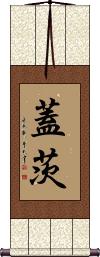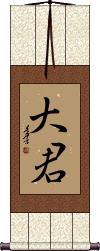Many custom options...
And formats...

Gates in Chinese / Japanese...
Buy a Gates calligraphy wall scroll here!
Personalize your custom “Gates” project by clicking the button next to your favorite “Gates” title below...
Gates
Gates
Guardian / Defender
Great Lord / Tycoon
大君 is the Japanese word Taikun. It's defined directly as liege, lord, or an alternate title for a shogunate.
The sound of this Japanese word entered the English lexicon by the 1800s but took the spelling of “tycoon.” Even President Lincoln was referred to as a Tycoon in the 1860s.
In Japan, this is still understood as “Great Lord” or “Big Boss.” In America, it means “Bill Gates” and “Warren Buffet.”
Not the results for Gates that you were looking for?
Below are some entries from our dictionary that may match your Gates search...
| Characters If shown, 2nd row is Simp. Chinese |
Pronunciation Romanization |
Simple Dictionary Definition |
夜叉 see styles |
yè chā ye4 cha1 yeh ch`a yeh cha yasha やしゃ |
More info & calligraphy: Yakshayaksha (Buddhist guardian deities sometimes depicted as demonic warriors) (san: yaksa); (given name) Yasha 乞叉; 藥叉; 閱叉 yakṣa, (1) demons in the earth, or in the air, or in the lower heavens; they are malignant, and violent, and devourers (of human flesh). (2) The 八大將, the eight attendants of Kuvera, or Vaiśravaṇa, the god of wealth; those on earth bestow wealth, those in the empyrean houses and carriages, those in the lower heavens guard the moat and gates of the heavenly city. There is another set of sixteen. The names of all are given in 陀羅尼集經 3. See also 羅 for rakṣa and 吉 for kṛtya. yakṣa-kṛtya are credited with the powers of both yakṣa and kṛtya. |
蓋茨 盖茨 see styles |
gài cí gai4 ci2 kai tz`u kai tzu |
More info & calligraphy: Gates |
闉 𬮱 see styles |
yīn yin1 yin |
inner gates |
三脫 三脱 see styles |
sān tuō san1 tuo1 san t`o san to sandatsu |
the three (gates of) liberation |
三門 三门 see styles |
sān mén san1 men2 san men mimon みもん |
Sanmen county in Taizhou 台州[Tai1 zhou1], Zhejiang {Buddh} large triple gate to temple; (surname) Mimon trividha-dvāra, the three gates; a monastery; purity of body, speech, and thought; idem 三解脫門 also 三業. |
二王 see styles |
èr wáng er4 wang2 erh wang niō におう |
the two guardian Deva kings The two guardian spirits represented on the temple gates, styled Vajrayakṣa 金剛夜叉 or 神 or 夜叉神. |
六門 六门 see styles |
liù mén liu4 men2 liu men rokumon ろくもん |
(surname) Rokumon six sense gates |
十玄 see styles |
shí xuán shi2 xuan2 shih hsüan jūgen |
十玄門 (十玄緣起) The ten philosophic ideas expressed in two metrical versions, each line ending with 門. v. 玄門. |
升形 see styles |
masugata ますがた |
(1) square (shape); (2) (in a castle) rectangular space between the inner and outer gates (where troops can gather); (place-name, surname) Masugata |
四門 四门 see styles |
sì mén si4 men2 ssu men yotsukado よつかど |
(surname) Yotsukado The four doors, schools of thought, or theories: 有 is the phenomenal world real, or 空 unreal, or both, or neither ? According to the Tiantai school each of the four schools 四教 in discussing these four questions emphasizes one of them, i. e. 三藏教 that it is real 通教 unreal, 別通 both, 圓通 neither; v. 有 and 空, and each of the four schools. In esoteric symbolism the 四門 are four stages of initiation, development, enlightenment, and nirvana, and are associated with E., S., W., and N.; with the four seasons; with warmth, heat, coolness and cold, etc. |
御門 see styles |
mikado みかど |
(1) emperor (of Japan); mikado; (2) (honorific or respectful language) (the gates of an) imperial residence; (place-name, surname) Mikado |
扁額 扁额 see styles |
biǎn é bian3 e2 pien o hengaku へんがく |
variant of 匾額|匾额[bian3 e2] framed picture or motto (usu. horizontal, hung over gates or lintels) |
斗形 see styles |
masugata ますがた togata とがた |
(1) square (shape); (2) square bearing block (at the top of a pillar); (3) (in a castle) rectangular space between the inner and outer gates (where troops can gather); square bearing block (at the top of a pillar) |
智門 智门 see styles |
zhì mén zhi4 men2 chih men chimon |
Wisdom gate; Buddha-wisdom and Buddha-pity are the two gates or ways through which Buddhism expresses itself: the way of enlightenment directed to the self, and the way of pity directed to others. |
月城 see styles |
yuè chéng yue4 cheng2 yüeh ch`eng yüeh cheng tsukishiro つきしろ |
semicircular defensive enclosure around city gates; crescent-shaped barbican (surname) Tsukishiro |
末伽 see styles |
mò qié mo4 qie2 mo ch`ieh mo chieh maga |
mārga; track, path, way, the way; the fourth of the four dogmas 四諦, i. e. 道, known as the 八聖道, 八正道 (or 八正門), the eight holy or correct ways, or gates out of suffering into nirvana. Mārga is described as the 因 cause of liberation, bodhi as its 果 result. |
枡形 see styles |
masugata ますがた |
(1) square (shape); (2) (in a castle) rectangular space between the inner and outer gates (where troops can gather); (place-name, surname) Masugata |
根門 根门 see styles |
gēn mén gen1 men2 ken men nemon ねもん |
(surname) Nemon The senses as doors (through which illusion enters). |
桝形 see styles |
masugata ますがた |
(out-dated kanji) (1) square (shape); (2) (in a castle) rectangular space between the inner and outer gates (where troops can gather); (place-name, surname) Masugata |
泉門 see styles |
izumikado いずみかど |
(1) soft spot (in the skull of an infant); fontanelle; fontanel; (2) (See 黄泉) gates of Hades; entrance to the underworld; (surname) Izumikado |
蓋茲 盖兹 see styles |
gài zī gai4 zi1 kai tzu |
Gates (name) |
讃歎 see styles |
sandan さんだん santan さんたん |
(noun/participle) (1) (Buddhist term) praising Buddha; sermon; (2) (Buddhist term) praise (second of the five gates of mindfulness); (3) (Buddhist term) style of Buddhistic song of praise, usually praising Buddha, the Bodhisattva, the Buddhistic teachings, etc.; (4) (archaism) rumor; rumour; hearsay; (n,vs,adj-no) praise; extolment; extollment |
讃談 see styles |
sandan さんだん |
(noun/participle) (1) (Buddhist term) praising Buddha; sermon; (2) (Buddhist term) praise (second of the five gates of mindfulness); (3) (Buddhist term) style of Buddhistic song of praise, usually praising Buddha, the Bodhisattva, the Buddhistic teachings, etc.; (4) (archaism) rumor; rumour; hearsay |
讚歎 see styles |
zàn tàn zan4 tan4 tsan t`an tsan tan zandan さんだん |
(noun/participle) (1) (Buddhist term) praising Buddha; sermon; (2) (Buddhist term) praise (second of the five gates of mindfulness); (3) (Buddhist term) style of Buddhistic song of praise, usually praising Buddha, the Bodhisattva, the Buddhistic teachings, etc.; (4) (archaism) rumor; rumour; hearsay to praise |
讚談 see styles |
sandan さんだん |
(noun/participle) (1) (Buddhist term) praising Buddha; sermon; (2) (Buddhist term) praise (second of the five gates of mindfulness); (3) (Buddhist term) style of Buddhistic song of praise, usually praising Buddha, the Bodhisattva, the Buddhistic teachings, etc.; (4) (archaism) rumor; rumour; hearsay |
門内 see styles |
monnai もんない |
(ant: 門外) inside the gates; (surname) Monnai |
ケーツ see styles |
geetsu ゲーツ |
(surname) Gates |
ケイツ see styles |
geitsu / getsu ゲイツ |
(personal name) Gates |
三脫門 三脱门 see styles |
sān tuō mén san1 tuo1 men2 san t`o men san to men san datsumon |
V. 三解脫 (三解脫門), but the former is only associated with無漏, or nirvāṇa. |
五念門 五念门 see styles |
wǔ niàn mén wu3 nian4 men2 wu nien men gonenmon ごねんもん |
{Buddh} five gates of mindfulness: worship, praise, vows, observation, prayers for the dead The five devotional gates of the Pure-land sect: (1) worship of Amitābha with the 身 body; (2) invocation with the 口 mouth; (3) resolve with the 意 mind to be reborn in the Pure-land; (4) meditation on the glories of that land, etc.; (5) resolve to bestow one's merits, e. g. works of supererogation, on all creatures. |
Click here for more Gates results from our dictionary
The following table may be helpful for those studying Chinese or Japanese...
| Title | Characters | Romaji (Romanized Japanese) | Various forms of Romanized Chinese | |
| Gates | 蓋茨 盖茨 | gài cí / gai4 ci2 / gai ci / gaici | kai tz`u / kaitzu / kai tzu | |
| Gates | ガテス | gatesu | ||
| Guardian Defender | 衛士 卫士 | eishi | wèi shì / wei4 shi4 / wei shi / weishi | wei shih / weishih |
| Great Lord Tycoon | 大君 | tai kun / taikun | ||
| In some entries above you will see that characters have different versions above and below a line. In these cases, the characters above the line are Traditional Chinese, while the ones below are Simplified Chinese. | ||||
Successful Chinese Character and Japanese Kanji calligraphy searches within the last few hours...







